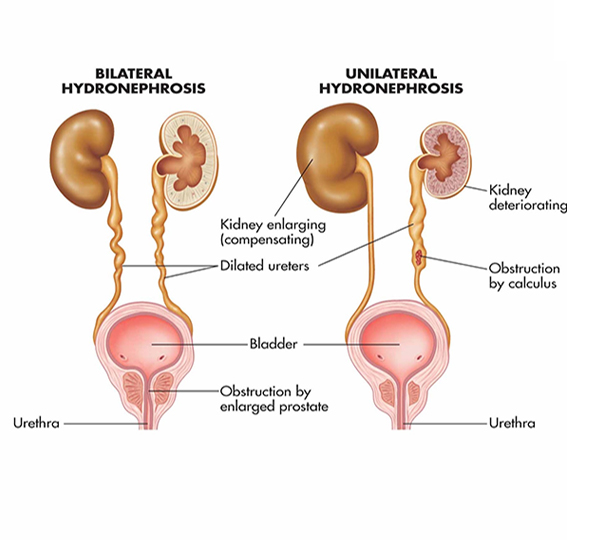
What causes hydronephrosis?
There are many causes of hydronephrosis, including:
- A blockage, which can occur between the kidney and the ureter (pelviureteric junction or PUJ), between the bladder and the ureter (vesicoureteric junction or VUJ) or in the urethra (posterior urethral valve).
- Vesico-ureteric reflux (VUR) occurs when the valve between the ureter and the bladder does not work properly and urine can travel back up to the kidney.
- Ureteric duplication, which affects about one per cent of all people. Children with ureteric duplication have two ureters leading from a kidney to the bladder, instead of one. Occasionally, they have a blockage at the lower end of one of the two ureters called an ureterocele.
- A multicystic dysplastic kidney (MCDK) is a non-functioning kidney made up of many cysts. Sometimes these shrivel up and disappear, but some need to be removed at a later stage.
How is hydronephrosis normally diagnosed?
It is often diagnosed before a baby is born, as the enlarged kidneys can be seen on an ultrasound scan. Hydronephrosis can also be diagnosed after the baby is born using ultrasound scans.
How is hydronephrosis normally treated?
If the hydronephrosis is diagnosed during pregnancy, early treatment will consist of monitoring with ultrasound, to check that the baby is growing normally and the kidneys are not getting too large.. After the baby is born, the hydronephrosis will be monitored using ultrasound scans in first week and subsequently as required and other tests. The overall treatment for hydronephrosis depends on what is causing it:
- If the cause is VUR, the child will probably be treated using antibiotics.
- If the cause is a blockage, the child may need an operation called a pyeloplasty to remove it.
- If the cause is a multicystic kidney, the affected kidney will shrivel up and disappear and therefore does not need to be removed. Sometimes, if the affected kidney is very large or causing high blood pressure, it may be removed leaving the normal one on the opposite side. Having only one kidney will not have any significant effect on the child's health.

